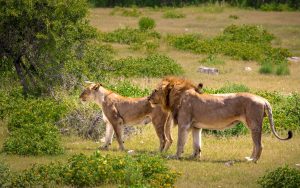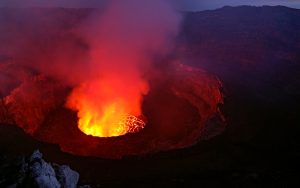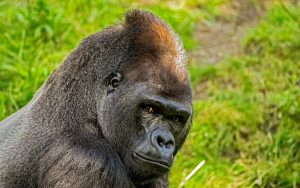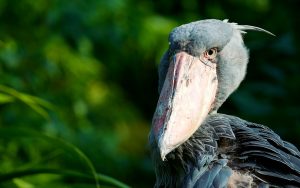15 Days Uganda Birding & Primates
Overview
This incredible safari takes you to some of best birding spots in the country. No other area in Africa can match Uganda’s amazing diversity of habitats and this richness is reflected in its incredible bird list of over 1085 species. Amongst these are many highly sought after birds, such as the unique Shoebill and numerous spectacular endemics of the Albertine Rift Valley, that are currently impossible to find anywhere else. Also you get to have amazing game drives and track chimpanzees and gorillas.
Included/Excluded
- All accommodation on Bed & Breakfast and Full Board status.
- Fuel & Transportation in Good condition 4*4 Vehicle with pop up roof.
- A professional and Experienced English speaking Guide.
- All relevant government tax.
- All activities as indicated in the program.
- Free Mineral Water in the vehicle while on the Tour.
- Flight and visa fees to Uganda and back home.
- International Travel insurance.
- Any Optional activities or those not included in the program.
- Tips, souvenirs, any soft/ alcoholic drinks and any personal purchases.
Tour Plan
Day 1 | Arrival in Entebbe.
Arrival at Entebbe International Airport meet your guide from Nsavi Safaris who will then transfer you to your hotel for an overnight.
Day 2 | Shoebill stork & Botanical Gardens.
After breakfast, drive to Mabamba Swamp, a large and accessible wetland on the shores of lake Victoria. This is one of the places to see the prehistoric looking Great shoebill stork. Here we also find some aquatic birds and marsh Harriers, if time allow search for the beautiful painted Pygmy goose. In the afternoon go birding in Entebbe botanical garden for the Orange weaver, golden backed weaver and other master builders of the Ploceidae family, superb sunbird, green hylia, bat hawk. And several garden birds exploiting this transitional habitat.
Day 3 | Transfer to Lake Mburo National Park
Drive to Lake Mburo National Park. Have a stop over and take photo poses at the equator. Proceed to Lake Mburo and have a game drive out to the vast savannah dotted with acacia and shrubs, and get to see Zebras, Topis, Warthogs, cape buffaloes and impalas. In the afternoon it is time for a boat-cruise on the lake where the must see is the African finfoot. As well as this we see native birds along the banks, Crocodiles, Hippos yawning and more birds during this 2 hours cruise.
Day 4 | Whole-day Birding.
Lake Mburo National Park contains multiple habitats, and our time will be divided between birding an extensive area of wetland, some forested areas, and open country with numerous mammals. No fewer than 300 different bird species have been recorded in the park, an indication of the high diversity present here. The more open grassland north of the camp, particularly along the Zebra Track, is worth exploring for species such as Coqui Francolin, Red-necked Spurfowl, Black-bellied Bustard, Temminck’s Courser, and African Wattled Lapwing, and it is here where small numbers of the migratory Brown-chested Lapwing can be regularly observed. Other species include; African Darter, Striated Heron, Spur-winged Goose, African Marsh Harrier, African Hawk-Eagle, CommonQuails, Water Thick-knee, Red-Faced Barbet, Rufous-naped and Flappet Larks, Rufous–chested Swallow, Yellow-throated Long Claw, Black Cuckoo-Shrike, Singing, Long-tailed (or Tabora) among others.
Day 5 | Morning Safari Walk
Early morning nature walks or game birding safari, get up early focusing on the Rwizi track it’s a dense population of some rare birds here, Tabora cisticola, Crested barbet, Red headed weavers, cuckoo shrikes etc chance to see, zebras, waterbucks, birds, buffaloes in. After breakfast, drive to Lake Bunyonyi famously known as the “Switzerland of Africa”; Lake Bunyonyi is at 1800meters above sea level and has an area with superb rich views with small resident and exotic bird species.
Day 6 | Bwindi Impenetrable National Park
Drive to Bwindi Impenetrable National Park –Ruhija Sector. The park is home to the endangered mountain gorillas and hosts a variety of spectacular birds including 23 of the 24 Albertine Rift endemic bird species including Blue-throated Broadbill, bar-tailed Trogon and other beautiful forest species. You shall go to bed earlier this evening so that you are well rested for thrilling experience of gorilla tracking the next day.
Day 7 | Gorilla trekking experience.
On this day, we set off early, with packed lunch, to the park headquarters for a briefing prior to Gorilla Tracking. This is the most exciting lifetime experience of all time. The gorillas are gentle animals and it is an unforgettable experience to photograph them as they interact. It is a wonderful experience to stare into the eyes of these gentle giants; watch them in awe as they play and go about their daily activities. It is indeed a “once in a lifetime” experience that you must never miss. Each encounter is different and has its own rewards; you are likely to enjoy the close view of adults feeding, grooming and resting as the youngsters frolic and swing from vines in a delightfully playful display.
Day 8 | Birding in Mubwindi Swamp.
We spend the entire day birding the Mubwindi Swamp area. The 4km trail to Mubwindi Swamp is the best place for some of the most difficult to find of all rift endemics. This includes Grauer’s (African Green) Broadbill, the beautiful Regal Sunbird, and Archer’s Robin-Chat. Mubwindi Swamp is also home to Dwarf Honeyguide, Stripe-breasted Tit, Ruwenzori Apalis. African Hill Babbler (sometimes treated as a separate species from Ruwenzori Hill Babbler), the rare and localized Grauer’s Scrub-Warbler. Some of the many species we have a chance of seeing here include Black Goshawk, Augur Buzzard, Crowned Hawk-Eagle, Handsome Francolin. Olive (Rameron) Pigeon, Bronze-winged Pigeon, Black-billed, Ruwenzori, and Ross’s Turaco, African, Barred Long-tailed, and African Emerald Cuckoos. Red-chested Owlet, Narina and Bar-tailed Trogons, Black and Cinnamon-chested Bee-eaters, Blue-throated Roller. White-headed Woodhoopoe, Grey-throated, Double-toothed, and Yellow-spotted Barbets, Western and Yellow-rumped Tinkerbird, Thick-billed and Dwarf Honeyguides. Rufous-necked Wryneck, Tullberg’s, Speckle-breasted, Elliot’s, and Olive Woodpeckers, African Broadbill, Rock Martin, Black Saw-wing. Gray and Petit’s Cuckoo-Shrike, Ansorge’s, Kakamega and Cabanis’ Greenbuls, White-tailed Ant-Thrush among others
Day 9 | Birding to Buhoma through "The Neck"
We bird to Buhoma section through “The Neck”. The Neck (where the forest narrows) offers excellent forest birding. Key species that we will look for there include many of the Albertine Rift Endemics that we may not have seen earlier. These include Handsome Francolin, Rwenzori Nightjar, Dwarf Honeyguide, African Green Broadbill, Archer’s Robin-Chat, Red-throated Alethe, Yellow-eyed Black-Flycatcher, Red-faced Woodland Warbler, Short-tailed Warbler, Grauer’s Warbler, Mountain Masked Apalis, Collared Apalis, Stripe-breasted Tit, Rwenzori Batis, Blue-headed Sunbird, Regal Sunbird, Strange Weaver, Dusky Crimsonwing. A few other species we may encounter as well include Ayres’s Hawk-Eagle, Fine-banded and Cardinal Woodpeckers, Willcocks’s Honeyguide, Kakamega Greenbul, Red-tailed Greenbul, Red-tailed Bristlebill, Blue-shouldered Robin-Chat, Mountain Wagtail, Cassin’s Flycatcher, Equatorial Akalat among others.
Day 10 | Birding on the Main Trail.
On this truly magical experience, we will search for species such as Olive Long-tailed Cuckoo, Bar-tailed Trogon, Dusky Tit, Kivu Ground-Thrush, White-bellied Robin-Chat, Equatorial Akalat, White-tailed Ant-Thrush, Red-throated Alethe, White-bellied Crested- Flycatcher, White-eyed Slaty-Flycatcher, Gray-green Bushshrike, Northern Double-collared Sunbird, Black-billed Weaver and Magpie Mannikin. High exposed perches in the open forest are favoured by African Goshawk; the dazzling Black Bee-eater, Blue-throated Roller, Sooty Flycatcher and forest starlings including Waller’s, Stuhlmann’s and Narrow-tailed. One of Bwindi’s star avian attractions is the diminutive, pitta-like Neumann’s Warbler, a vocal yet very secretive bird! Other under-storey birds we hope to see include displaying African Broadbill; Banded Prinia and the handsome Black-faced Rufous-Warbler. The mid-storey and canopy support Elliot’s and Tullberg’s Woodpeckers; Cabanis’, Kakamega and Ansorge’s Greenbuls; the strange Grauer’s Warbler and White-browed Crombec. The rare Jameson’s Antpecker may also be seen probing under moss on dead branches or gleaning warbler-like in the canopy. Overhead, Scarce Swifts forage over the forest.
Day 11 | Queen Elizabeth National Park - Ishasha sector.
Today transfer to Queen Elizabeth National park through the Ishasha sector of Queen Elizabeth National Park (popularly known for its tree-climbing lions) while birding on the way. Birding on the way may produce species such as Grey-capped Warbler, African Long Crested Eagle, Augur Buzzard, Mackinnon’s Fiscal, Black-headed waxbill, Black and white Manikin, Senegal Coucal, Red Chested Cuckoo, and others. Continue to the northern sector of the park to the lodge.
Day 12 | Whole day birding experience.
Explore Queen Elizabeth National Park in the cool morning with keen birding and game viewing. We do an early game drive that exposes us to diverse animals, Big 5 members Elephants, Buffalos, big cats- Lions, Leopards more times in the evening, warthogs, Hunchback carnivals like Hyenas and many more species can be spotted along the Circuits. There is a rich bird life especially our version of storks in the wetland spots. In the Afternoon have an exciting Boat cruise on the famous Kazinga channel, get an opportunity for waterside birds and abundant Hippopotamus. Amongst the birds, you are likely to encounter include African Skimmer, Striated Heron, African Spoonbill, Water Thick-knee, Three-banded Plover, Marsh, Green, Wood and Common Sandpiper, Gray-headed Gull, Plain Martin Lesser Swamp-Warbler and Yellow-billed Oxpecker among others.
Day 13 | Kibale Forest National Park.
Drive to Kibale National Park The park also boasts 325 bird species, including 6 that are endemic to the Albertine rift region. If you are lucky you may also see the African pitta, Green-breasted Pitta, Black bee-eater, Yellow-rumped Tinkerbird, Little Greenbul, Black-eared Ground-thrush, Brown-chested Alethe, Blue-breasted kingfisher, Abyssinian ground thrush, and the crowned eagle, African Emerald Cuckoo, Purple-headed Starling, Black-billed Turaco, Yellow-billed Barbet, Grey-throated Barbet, Blue-throated Roller, Narrow-tailed Starling, Western Black-headed Oriole
Day 14 | Chimpanzee trekking & Birding experience.
Assemble for briefing and thereafter enter the forest to look for our cousins, the Chimps. The activity takes 1 to 5 hours. In the afternoon, we may choose to go to Bigodi Wetland famous with riverine forest birds otherwise along the main road may also be productive. Kibale National Park is a good site for a number of birds that are hard to find elsewhere. These include Speckle-breasted Woodpecker, Cabanis’s Greenbul and Joyful Greenbul as well as White-spotted Flufftail, Dusky and Olive Long-tailed Cuckoo, Lesser Honeyguide, Blue-shouldered Robin-Chat, White-chinned Prinia, Grey Apalis, Olive-green Camaroptera and White-collared Olive back.
Day 15 | Entebbe & Departure.
You will start your journey back to Entebbe International Airport connect with your onward flight back home.








